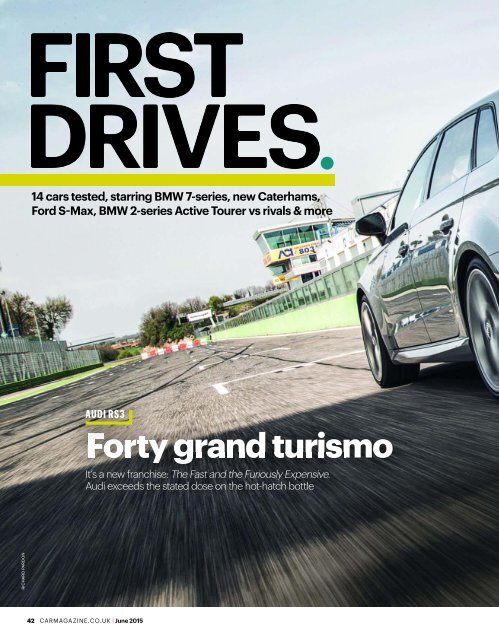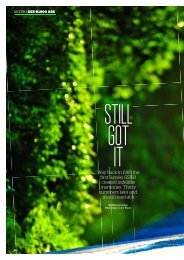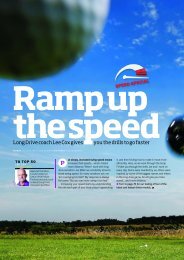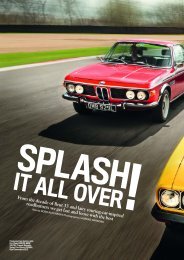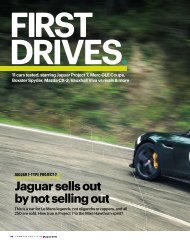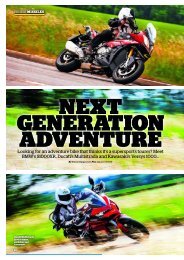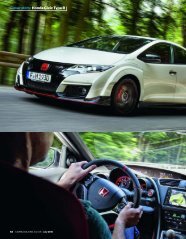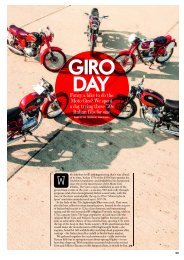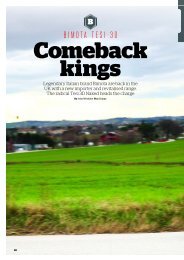Create successful ePaper yourself
Turn your PDF publications into a flip-book with our unique Google optimized e-Paper software.
14 cars tested, starring BMW 7-series, new Caterhams,<br />
Ford S-Max, BMW 2-series Active Tourer vs rivals & more<br />
AUDI RS3<br />
<strong>Forty</strong> <strong>grand</strong> <strong>turismo</strong><br />
It’s a new franchise: The Fast and the Furiously Expensive.<br />
Audi exceeds the stated dose on the hot-hatch bottle<br />
RICHARD PARDON<br />
42 CARMAGAZINE.CO.UK | June 2015
ALL THUGGISH ARCH flares<br />
and bluffly raked windscreens,<br />
race-bred triumphs of function over<br />
form, four short-wheelbase Sport<br />
Quattros greeted us as we rolled<br />
through the gates of Rome’s Vallelunga Circuit at<br />
the launch of the new Audi RS3. The link between<br />
a monster-powered everyday hatch and one of the<br />
world’s most iconic homologation specials might<br />
seem tenuous, but Audi was keen to reinforce the<br />
key differentiator between the RS3 and lesser hot<br />
hatches: its five-cylinder engine. Or maybe it hoped<br />
that laying on a display of cars that are now worth<br />
an eye-watering £270,000 each according to a recent<br />
auction price would help deflect attention from the<br />
RS3’s own how much!? price tag.<br />
The how much? in question is £39,950, some<br />
£1755 more than even rival AMG’s hugely expensive<br />
A45, but Audi UK reckons the average spend<br />
will be closer to £50k and that the circa-1000 it’ll<br />
sell each year is limited not by demand, but supply.<br />
Evidently there are plenty of people who see<br />
nothing wrong with paying Porsche Cayman S<br />
money for a hatch. But does the RS3 really add up?<br />
Based around the same hybrid steel/aluminium<br />
MQB platform as lesser A3s and its Golf<br />
cousin, this 1520kg second-generation RS3 is<br />
55kg lighter and 28bhp stronger, the 2.5-litre<br />
transverse five it shares with the RS Q3 SUV<br />
being boosted from 334bhp to 362bhp. That’s<br />
backed up by 343lb ft of torque, 11lb ft more than<br />
before, delivered through a standard seven-speed<br />
dual-clutch transmission to a Haldex four-wheeldrive<br />
system that can freeze the front wheels out<br />
entirely when they find the going too slippery,<br />
and send 100% of the torque to the back axle.<br />
Push both pedals and pop the left to engage<br />
the launch control mode and the RS3 hurls<br />
itself forward with a garnish of tyre slip, passing<br />
62mph in 4.3sec, 0.3sec quicker than before.<br />
Top speed is limited to 155mph as standard,<br />
or you can pay extra to up the limit to 174mph.<br />
It’s a poor man’s<br />
Golf R, in that<br />
you’ll be poor after<br />
you’ve bought it.<br />
At 174mph you<br />
might also be<br />
under arrest<br />
Incredibly, Audi expects<br />
several Brits to do this.<br />
Should be really handy on<br />
the North Circular. There’s<br />
so much torque, and so<br />
much of it is available from<br />
little over 1500rpm, that<br />
performance is effortlessly fast. Perhaps that’s<br />
why it doesn’t always feel quite as humungously<br />
rapid as it clearly is. And it is rapid. What looked<br />
like a half-chance to overtake one car suddenly<br />
turned into an opportunity to do two at the same<br />
time. Indulge too often though and you’ll pay<br />
a price at the pumps for that extra cylinder, the<br />
RS3’s 35mpg combined figure likely translating<br />
to little more than the 25mpg our old RS3-long<br />
termer managed.<br />
Audi’s engineers were making a big noise about<br />
the optional sports exhaust with its two adaptive<br />
flaps, but it still left us wanting a little more. This<br />
is the RS model, after all. What noise there is, is<br />
June 2015 | CARMAGAZINE.CO.UK 43
And you don’t<br />
even get the TT’s<br />
funky virtual<br />
cockpit. Gah!<br />
pure five-pot pleasure, and the sound effects are all<br />
real, not microchip-generated. BMW’s M135i, and<br />
Golfs GTI and R, all rely on synthesised sounds.<br />
But who cares when they’re all also fast and<br />
flighty, nimble things that goad you into driving<br />
like a loon at every opportunity? The old RS3,<br />
whizzy but wooden, was so one-dimensional it<br />
made watching South Park feel like an IMAX<br />
3D experience. Is this one any better? None of the<br />
new RS3 test cars came with the optional magnetorheological<br />
adaptive dampers, but from the<br />
way it crashes into urban potholes, we’d say you’d<br />
be wise to add them to yours. The standard 19in<br />
wheels transmit too much shock back into the<br />
cabin at low speeds, but up the pace and leave the<br />
city behind and the RS3 starts to shine brighter.<br />
It feels eager and alert, its two-turns lock-to-lock<br />
variable-ratio rack, colossal grip and tight body<br />
control making direction changes instant, and<br />
there’s more fingertip feel this time around.<br />
Audi’s engineers say that it’ll even oversteer<br />
in low-grip situations, though on the hot, dry<br />
tarmac of Vallelunga, the most we could feel<br />
was a subtle yawing that helped twist<br />
the nose but never required anything as<br />
unseemly as opposite lock. Even with the<br />
latest-generation four-wheel-drive system<br />
working twice as fast to apportion torque,<br />
this is still a car that responds better to<br />
measured inputs. Barrel clumsily into a<br />
corner and understeer awaits. Try a neater<br />
approach, use the excellent brakes (front<br />
ceramics as an option from the autumn)<br />
to shed speed, and carve your way cleanly<br />
through and you’ll be faster and have more fun.<br />
We’d be surprised, though, if the RS3’s entertainment<br />
factor isn’t thrown into sharp perspective<br />
by Ford’s also four-wheel-drive Focus RS and<br />
its ‘Drift’ mode when we drive it later this year. For<br />
all its competence, the RS3 never really feels quite<br />
naughty enough to justify that badge, or its price.<br />
What the Focus can’t hope to emulate is the<br />
Audi’s stunning interior finish. It’s largely conventional,<br />
with no TT-like full TFT display, but<br />
Five doors, battleship<br />
paintjob… looks so<br />
innocent, doesn’t it?<br />
UP AGAINST<br />
BETTER THAN<br />
AMG A45 Though RS3 can’t<br />
touch Merc’s 40mpg<br />
WORSE THAN<br />
Audi RS4 £48k buys a year-old<br />
5k-mile minter<br />
WE’D BUY<br />
Golf R Similar oily bits,<br />
more fun, less dough<br />
the materials are first rate and details<br />
such as the red insert in the circular<br />
heater vents that moves as you pull<br />
the central plunger to alter that<br />
volume of airflow really lift the ambience.<br />
The only real disappointments<br />
are the cheap-feeling plastic gearshift<br />
paddles, and the use of a boring old<br />
black plastic switch for the Drive<br />
Select controller governing throttle<br />
response (always slightly dull), steering<br />
weight and, if fitted, the sport<br />
exhaust and adaptive dampers.<br />
If it’s a surprise to find that the RS3<br />
comes only in five-door Sportback<br />
form, the reality is there’s no demand<br />
among big-money hatch buyers for<br />
three doors, and the five-door shell’s<br />
35mm longer wheelbase helps make<br />
this a comfortable four-seater. It’s<br />
a pity the measly 280-litre boot,<br />
compromised by the space-sappping<br />
battery relocated beneath its floor,<br />
severely limits its touring talents.<br />
There’s a four-door saloon version<br />
due next year, but it isn’t for the UK.<br />
But let’s get back to that price,<br />
which would buy a Porsche Macan S,<br />
Merc’s excellent C450 AMG estate, or<br />
the sublime, and vastly cheaper, Golf<br />
R. On the one hand it seems scandalous<br />
that even if you can get your head around<br />
paying £40k for a hot hatch, you’ll still have to<br />
find more cash to get the sports exhaust, adaptive<br />
dampers, proper Recaros and even sat-nav that<br />
you’ll inevitably want. But that Golf R, ostensibly<br />
£10k cheaper on paper, doesn’t have any of those<br />
morsels either, and when you option one up with<br />
five doors, DSG and Nappa leather to give it the<br />
stuff the RS3 does come with, you’re a lot closer to<br />
£40k – and still down 67bhp. That said, improved<br />
as the second-gen RS3 is, I’d put money on the<br />
eventual group test showing that the Golf, and not<br />
the Audi, is VW’s finest, most exciting, hot hatch.<br />
CHRIS CHILTON @chrischiltoncar<br />
Audi RS3<br />
> Price £39,950 > Engine 2480cc 20v 5cyl, 362bhp<br />
@ 5500-6800rpm, 343lb ft @ 1625-5550rpm ><br />
Transmission Seven-speed dual-clutch, four-wheel<br />
drive > Performance 4.3sec 0-62mph, 155mph,<br />
34.9mpg, 189g/km CO2 > Weight 1520kg > On Sale<br />
Summer<br />
LOVE<br />
Rapid, refined,<br />
strong residuals<br />
HATE<br />
Price, stif<br />
ride, good bits<br />
optional<br />
VERDICT<br />
Good… but not<br />
£50k good<br />
★ ★ ★ ★ ★<br />
44<br />
CARMAGAZINE.CO.UK | June 2015
Cabrio test: 911 Turbo S vs California T<br />
Plot Porsche and Ferrari on a graph and their lines meet only once: here. But which<br />
92 1XX CARMAGAZINE.CO.UK | May 2014 | June 2015
£150k, 552bhp turbo cabrio aces the Very-Fast-Posing test and gets the girl?<br />
Words Ben Barry | Photography Mark Bramley<br />
June 2015 May | CARMAGAZINE.CO.UK 2014 | 1XX 93
Cabrio test: 911 Turbo S vs California T<br />
IMAGINE BOTH PORSCHE and Ferrari<br />
sheltered under Volkswagen or Fiat’s umbrella.<br />
Mostly, they’d be entirely complementary stablemates:<br />
Porsches typically sit in the £40-£100k<br />
bracket, Ferraris between £175-£225k, so market<br />
cannibalisation would be near non-existent.<br />
If CEOs Müller or Marchionne were to have<br />
headaches, it’d be at £150k, the only price clash.<br />
Barring the 918 there is no costlier Porsche than<br />
the 911 Turbo S Convertible, no cheaper Ferrari<br />
than the California T, directly comparable convertibles<br />
that make exactly 552 ponies and weigh<br />
1750kg, give or take. They also tilt more towards<br />
luxury performance than the driver-focused<br />
thrills we often associate with both marques.<br />
Suppose you’re Müller or Marchionne, then;<br />
which gets the bullet?<br />
The 911 Turbo S Convertible felds a 3.8-litre turbocharged fatsix,<br />
seven-speed dual-clutch transmission and all-wheel drive. A 911<br />
Turbo costs £121k, removing the roof adds £7500, and appending an<br />
S injects 39bhp and 66lb ft extra for 552bhp/553lb ft. It also introduces<br />
active anti-roll control, carbon brakes, LED headlights and the<br />
Sport Chrono pack with its dynamic engine mounts to get on tippy<br />
toes and touch Ferrari territory at £149,668.<br />
All manner of options are available, but our tester gets only<br />
Adaptive Cruise Control, black rims, a brushed aluminium gear<br />
shifter and assorted nick-nacks to tickle the total to £152,703. Pretty<br />
representative, I’d say.<br />
The £154,490 Ferrari California T is a comprehensive development<br />
of the California. There’s revised styling inspired by the 250<br />
Testa Rossa’s pontoon lines, 15% more interior space, an uprated<br />
chassis, faster gearshifts and an all-new engine. It’s also Ferrari’s<br />
sole front-engined convertible, the only way for Tifosi to carry four<br />
roof-down.<br />
The California T is the frst Prancing Horse to go turbo since<br />
1987’s F40 – the 488 GTB comes next – and features a 3.85-litre<br />
V8 producing 552bhp and 557lb ft. Like the Porsche, it gets a<br />
dual-clutch transmission, but the Ferrari sends power to the rear<br />
wheels alone, and there’s only one favour of California T. Choice<br />
instead comes via the options list, and Ferrari has done more<br />
box-ticking than a Whitehall bureaucrat. The price swells to<br />
£200,628 as a result, highlights including £7k Rosso California<br />
Red paint, £4k contrast roof, £4k parking cameras, £3.5k 20-<br />
inch rims and £3k audio.<br />
IT’S A BLUSTERY spring day when we meet at Barry Island,<br />
Wales. The holiday resort is out-of-season quiet, but every local<br />
is drawn like iron flings to the magnetic Ferrari. The Porsche is<br />
almost universally overlooked. Either way, owners may feel aggrieved;<br />
I take the chance to familiarise myself with the Porsche.<br />
You sit down low, standard 18-way electric memory seats<br />
hugging you comfortably and ofering more adjustment than<br />
a dentist’s chair. The steering wheel is small, perfectly sculpted<br />
at the crucial quarter-to-three interface and disconcertingly<br />
multi-functionless, while the centre console – idiosyncratically<br />
busy with buttons – rises upwards, ofering the Excalibur of<br />
gear levers into your left hand. Combined with a relatively high<br />
waistline, you feel cocooned, the 911 driving position focused,<br />
purposeful.<br />
There’s plush leather, perfect stitching,<br />
Monty Python’s<br />
Whicker Island<br />
was full of Alan<br />
Whickers. Barry<br />
Island, however,<br />
contains a<br />
maximum of one<br />
Ben Barry, plus<br />
£300k worth of<br />
super cabrios<br />
brushed aluminium trim and build quality<br />
born from the Blitz, and the luxury<br />
touches you’d expect in this segment are<br />
very much in evidence: heated seats, cup<br />
holders, sat-nav, Bose sounds, cruise<br />
control, parking sensors, all factory-ft.<br />
But frst impressions of the 911 at a<br />
cruise disappoint. The steering has an 4<br />
94 1XX CARMAGAZINE.CO.UK | May 2014 | June 2015
Behold the first turbocharged Ferrari<br />
engine for 28 years. 3.85-litre V8, 552bhp,<br />
557lb ft, and not enough character<br />
Porsche’s active<br />
aero a sure sign<br />
this is more than a<br />
posing machine.<br />
Spoiler lifts at<br />
75mph and again<br />
at the push of a<br />
button<br />
June 2015 | CARMAGAZINE.CO.UK 95
Cabrio test: 911 Turbo S vs California T<br />
unappealing syrupiness up top, there are anodyne noises from<br />
the engine, and the lumpen ride quality feels more tectonic than<br />
Teutonic. Why, when the Turbo has adaptive suspension, can’t<br />
Comfort ofer more of it?<br />
The Ferrari is a very diferent proposition. The seats are<br />
surprisingly fat, frm and lacking in support, ofer less generous<br />
adjustment, and even delicate piano-player fngers will chafe<br />
between seat controls and door casings. Where you’re ensconced<br />
in the Porsche, the Ferrari’s waistline dips down, inviting you<br />
to spill an elbow over the side and bask in sunshine; it subtly<br />
changes your mindset as you thumb the starter.<br />
Fit and fnish generally feels of high quality, and there’s cruise<br />
control, sat-nav, parking sensors, automatic lights and wipers,<br />
and electric seats all thrown in, but the fllets of silver trim look<br />
easily damaged and too Tin Man for comfort. A manettino dial<br />
on the small, button-festooned steering wheel is limited to just<br />
three settings, not fve – Comfort, Sport, ESC-Of – a little hint<br />
that this Prancing Horse is tamer than siblings.<br />
Yet while this is clearly a softer Ferrari, equipment isn’t as<br />
generous as the Porsche – no heated seats here – and if you’d just<br />
swapped from a Merc SL63 you’d think George Osborne had<br />
whipped through the cabin on some mad austerity bender.<br />
Thankfully, a brief urban drive proves more convincing. The<br />
California’s 10% swifter, super-light steering imbues spritely<br />
immediacy, and road-surface texture transitions from tyres to<br />
hands, a reminder that Ferrari retains electro-hydraulic steering<br />
where Porsche’s electro-mechanical racks only approach<br />
tactility in the GT3. The California also rides with a supple<br />
pliancy, and the V8 engine – turbocharged, remember, the killer<br />
The small matter of fuel economy<br />
OBVIOUSLY, ANYONE<br />
who’s petrol-station-averse<br />
will run a mile, but…<br />
Porsche claims 28.5mpg<br />
on the combined cycle,<br />
Ferrari 24.1mpg – a 15%<br />
improvement over the<br />
old 4.3. We calculated<br />
the fuel figures over 113<br />
miles in the Porsche, 114<br />
in the Ferrari, which took<br />
in low-speed urban routes<br />
with frequent stops for<br />
photography, then ‘more<br />
enthusiastic’ driving on<br />
empty B-roads. We spent<br />
£41.14 on 37.10 litres<br />
of fuel for the Porsche,<br />
of sound – makes some promising growls at part-throttle.<br />
Initial photography complete, we depart for more challenging<br />
terrain in the Brecon Beacons. I jump in the Porsche, and plump<br />
grey clouds that just whipped us with hail dart to sea, leaving a<br />
bright blue sky overhead.<br />
Press a button and the Turbo S Convertible’s fabric roof drops<br />
in around 15 seconds at up to 34mph, which sounds modest but<br />
feels like dropping the window on a 747. With windows raised,<br />
you’re at the eye of the storm, protected from the bluster.<br />
The advantages of the Porsche’s stow-on-the-go system<br />
are clear: you can simply slow to operate the roof, rather than<br />
attempting to at the trafc lights, failing and then driving of in<br />
what appears to be a sporting scissor-lift.<br />
The 911’s roof doesn’t eat into luggage space when open, which<br />
is a moot point given that the Porsche is rear-engined. Instead<br />
you’ve got a 115-litre frunk (easily trumped by the Fezza’s 240<br />
litres) and rear seats to store things when you’re not carrying<br />
(very) small passengers.<br />
£51.70 on 46.62 litres of<br />
fuel for the Ferrari. The<br />
result? The 911 Turbo S<br />
Convertible averaged<br />
13.9mpg, the California T<br />
11.1mpg. We’d expect both<br />
figures to substantially<br />
improve during more<br />
typical use. Honest!<br />
96 CARMAGAZINE.CO.UK | June 2015
A lightweight magnesium roof frame contributes to a weight<br />
penalty of just 70kg compared with the coupe, and helps to retain<br />
the 911’s iconic lines. Torsional rigidity is doubtless compromised,<br />
but this feels a very together car on some pretty ragged<br />
surfaces.<br />
CJ Hubbard’s following in the California, but his roof stays<br />
firmly closed. This says nothing of CJ’s tolerance for cold, and<br />
everything about Ferrari’s retractable hardtop. Opening the roof<br />
obscures the numberplate, presumably explaining why you must<br />
park to operate it. It also eats into luggage space, and requires a<br />
luggage cover to be in place before it opens; there are more caveats<br />
and compromises to this high-speed tan. We timed it at around<br />
20sec to stow.<br />
At first, negative early impressions of the 911 are bolstered by<br />
rowdy tyre roar from the huge rear 305-section tyres. But as we<br />
head off the major routes and follow a road that unfurls over the<br />
Brecon Beacons, the 911 Turbo S comes alive.<br />
A wallflower at low revs, the flat-six begins to howl charismatically,<br />
propelling the Turbo forwards on a tsunami of roaring<br />
boost with rolls of thunder when you<br />
back off. There’s small if detectable lag,<br />
Porsche goes from<br />
lid closed to full<br />
sun in 15sec at up<br />
to 34mph. Ferrari<br />
takes 20sec, once<br />
you’ve stopped,<br />
fitted the luggage<br />
cover and (it feels<br />
like) filled out a<br />
form in triplicate<br />
so there’s incredible flexibility and sharp<br />
response, and when you dip in and out of<br />
the throttle through twisty corners, there<br />
are none of the nasty shunts you might<br />
expect when the boost suddenly shuts off;<br />
there’s a surging, non-linear intensity to<br />
this delivery, but it’s also very precise.<br />
Combined with super-quick dual<br />
-clutch changes and seven closely stacked gears, there’s always a<br />
decent slug of performance on hand.<br />
The 911’s ride also smoothes at speed, and somehow you forget<br />
the sticky steering, which starts to feel well-weighted, precise and<br />
usefully speedy.<br />
Soon you’re stitching together corners with instinctive fluidity,<br />
rolling onto the carbon brakes with their excellent feel and<br />
stopping power, dropping multiple cogs on the paddleshifters,<br />
then leaning on the front end and squeezing the power early to<br />
fast-forward down the next straight.<br />
Rear-wheel steering subtly adds to the agility, and the allwheel-drive<br />
system is surreally sticky, but also satisfyingly<br />
rear-biased. If you work the chassis very hard in tighter corners<br />
and turn off all electronics, you’d best anticipate the spike of<br />
boost that’ll spit you quickly sideways on corner exit.<br />
Up here, on these roads, the Porsche is a point-to-point monster:<br />
braking, steering, body control, power, gear shifts, they all<br />
just gel to propel you cross-country so quickly even the crows<br />
must puzzle that they’d missed a more direct route. Only when<br />
you go back to doing what most owners will do, dropping the<br />
roof, winding back the pace, do the flaws re-appear. That’s pretty<br />
unfortunate, but the high-speed rush leaves you inclined to cut<br />
some slack.<br />
I swap into the Ferrari, picking up the pace slowly. Those<br />
earlier urban impressions are reinforced, particularly its more<br />
tactile steering, composed ride – on £3k optional magneride<br />
suspension! – and more characterful engine. If you spend more<br />
time wafting than hooning – most owners will – the Ferrari is the<br />
choice. <br />
If you spend more<br />
time wafting than<br />
hooning, the Ferrari<br />
is the choice<br />
June 2015 | CARMAGAZINE.CO.UK<br />
97
Red manettino dial<br />
on the right of the<br />
wheel usually has<br />
five settings; here<br />
it has just three.<br />
An indication of<br />
California’s lack of<br />
hardcore ambition<br />
Sources in Stuttgart report that signing<br />
off this interior was the real reason<br />
Ferdinand Piëch was forced to resign<br />
But if you want to uncork more than a handful of those 552<br />
prancing ponies, you could be disappointed.<br />
The engine is technically accomplished, but lacking the raw<br />
emotion of the old naturally aspirated V8. You simply cannot<br />
feel turbo lag, and the staggered peak torque from third to seventh<br />
gear encourages you to chase the 8000rpm redline like we<br />
did in the good old days when CO2 was an odourless, naturally<br />
occurring gas that plants gulped for fun. The fgures bear this<br />
out: the Porsche drops its torque pants at 2100rpm, the Ferrari<br />
teases you to 4750rpm.<br />
Hence you do less short-shifting in the Ferrari than you do<br />
in the Porsche. But ultimately the new, cleaner V8 falls short,<br />
because when you do really rev it, the power delivery feels thin,<br />
and the sound efects taper of. At high revs, it’s not particularly<br />
characterful at all, which happens to be the point where the old<br />
4.3 would soar and wail and come over all F1 car (before they<br />
too, were turbocharged, and ruined). At least the gear shifts<br />
remain incredibly incisive, and a farty little trill between ratios<br />
augments the drama.<br />
The California’s chassis is lowered 10mm and features spring<br />
rates some 15% stifer than before, but still it rolls like a P&O<br />
ferry in a churning sea and you’ll have a family of illegals running<br />
for the gaps between arch and body when you try to get<br />
back through Calais.<br />
There’s actually a good front end on this<br />
car, and plenty of low-speed traction given<br />
the signifcant extra hit of torque, but the<br />
very quick steering feels at odds with such a<br />
rolly body. Tip it into a corner and you can feel<br />
the chassis lag behind, giving a disconnected<br />
lack of precision, compromised traction<br />
and the need to take numerous nibbles at<br />
the steering. Sometimes it’s fun to unstick a<br />
car’s rear end, but at high speed and with soft<br />
suspension, the Cali just feels alarming. And<br />
that’s with the stifer setting selected.<br />
A still-too-intrusive Sport stability control<br />
setting doesn’t help: sprint cross-country and<br />
you’ll be constantly thwarted by that wadingthrough-mud<br />
frustration.<br />
The alternative is to turn everything of,<br />
but the lack of outright control, amplifed<br />
by the turbo torque, makes this an often<br />
unappealing proposition.<br />
That night, we head back to the hotel, the<br />
rain thumping down on bucking B-roads.<br />
CJ’s up front in the 911, and I can hear him<br />
getting on the throttle early and the Turbo<br />
just digging in and powering away. I feel<br />
much more hesitant in the Ferrari, and even<br />
the awkward wiper buttons on the steering<br />
wheel take too much mental capacity when<br />
trying to cover ground quickly. In so many<br />
ways, the two cars really are polar opposites.<br />
The Porsche is a relatively simple fx: it<br />
needs more low-speed comfort and refnement,<br />
and its engine and steering could be<br />
more characterful. It’s just unfortunate that<br />
this is so crucial to typical daily use, and that<br />
you need space to tap the Turbo’s brilliance;<br />
think about how much of that performance<br />
you’ll use before buying.<br />
The California T is more of a conundrum:<br />
it isn’t good enough to drive to feel like a true<br />
Ferrari, yet that sacrifce isn’t mitigated by<br />
levels of luxury you might fnd in a Mercedes<br />
SL. Ferrari has proved it can strike this<br />
balance with the incredible F12, a luxury GT<br />
with driving dynamics to make you whoop.<br />
The California should feel hewn from similar<br />
stuf; it doesn’t. But if you’ll only ever use<br />
six tenths of the performance and you’re a sucker for attention,<br />
there’s a high probability it’ll ft your requirements better than<br />
the 911.<br />
For me? 911 Turbo S Convertible gets the nod; California T<br />
gets the bullet.<br />
@IamBenBarry<br />
98 SUBSCRIBE & SAVE UP TO 66%! GREATMAGAZINES.CO.UK/CAR | June 2015
Cabrio test: 911 Turbo S vs California T<br />
SPEC<br />
FERRARI CALIFORNIA T<br />
Price £154,490<br />
As tested £200,628<br />
Engine 3855cc 32v V8 bi-turbo,<br />
552bhp @ 7500rpm,<br />
557lb ft @ 4750rpm<br />
Transmission Seven-speed dualclutch<br />
auto, rear-wheel drive<br />
Suspension Double-wishbone<br />
front; multi-link rear<br />
Performance 3.6sec 0-62mph,<br />
196mph, 24.1mpg, 273g/km<br />
Length/width/height<br />
4570/1910/1322mm<br />
Weight/made of 1730kg/aluminium<br />
Rating ★★★★★<br />
PORSCHE 911 TURBO S<br />
CONVERTIBLE<br />
Price £149,668<br />
As tested £152,703<br />
Engine 3800cc 24v flat-six bi-turbo,<br />
552bhp @ 6500-6750rpm,<br />
553lb ft @ 2100-4250rpm<br />
Transmission Seven-speed dualclutch<br />
auto, four-wheel drive<br />
Suspension MacPherson front;<br />
multi-link rear<br />
Performance 3.1sec 0-62mph,<br />
197mph, 29mpg, 321g/km<br />
Length/width/height<br />
4506/1880/1292mm<br />
Weight/made of1750kg/steel,<br />
aluminium<br />
Rating ★★★★★<br />
It can be great fun<br />
doing this, but not<br />
in a California T.<br />
Wallowy and a bit<br />
scary<br />
If both engines<br />
shot sideways<br />
and swapped cars<br />
from this position<br />
they’d both be in<br />
a better place, ie,<br />
mid-mounted<br />
June 2015 | CARMAGAZINE.CO.UK 99
Giant test: Jaguar XE vs rivals<br />
Jaguar XE<br />
R-Sport 2.0D<br />
106 CARMAGAZINE.CO.UK | June 2015
Mercedes C220<br />
BlueTEC AMG Line<br />
BMW 420d<br />
Gran Coupe<br />
G I A N T T E S T<br />
They think<br />
it’s all over…<br />
… but is it now? Jaguar’s heralded XE has<br />
talked a good game to scare the seemingly<br />
unbeatable Germans from BMW and Merc.<br />
Now it’s time to do the talking on the pitch<br />
Words Chris Chilton Photography James Lipman<br />
June 2015 | CARMAGAZINE.CO.UK 107
Giant test: Jaguar XE vs rivals<br />
Every company car<br />
driver with aspirations<br />
needs to be right here,<br />
right now<br />
108 CARMAGAZINE.CO.UK | June 2015
ORGET THE X-TYPE, the made-over<br />
F<br />
Mondeo that was supposed to take Jaguar to<br />
300,000 units a year but struggled to sell half<br />
its predicted volumes. This time Jag is taking<br />
things seriously. Based on a cut down version<br />
of the new XF’s platform, the rear- (and<br />
eventually four-) wheel drive XE is powered<br />
by a brand new range of engines, features<br />
fancy double-wishbone front suspension<br />
and a body made almost entirely from aluminium.<br />
It has a new multimedia system, the first electric power<br />
steering Jag has deemed worthy of putting in a production car<br />
and sophisticated traction management to deal with snowy<br />
conditions. Like we said, forget the X-type.<br />
But even with an arsenal like that the XE has got its work cut<br />
out, both in the showroom and up here in the mountainous<br />
Basque region of northern Spain. Mercedes’ new C-class has<br />
completely shaken the sector up by refocusing on comfort and<br />
luxury. A proper junior S-class, it’s the only car in the class to offer<br />
air-sprung suspension. And let’s not forget the 3-series. A sales<br />
titan, it’s got every angle covered, but always with an eye on handling<br />
over luxury. For this test though, we picked its 4-series Gran<br />
Coupe brother. Fractionally sharper in style and dynamic terms,<br />
its lift-back boot gives it a practical advantage over the 3-series, but<br />
most of what we’ll be talking about here applies to the 3-series too.<br />
These are heartland company cars. Jaguar has been surprised<br />
by early demand for the 197bhp and 237bhp 2.0 petrols (there’s<br />
a punchy 335bhp 3.0 supercharged V6 from the F-type available<br />
too), but although there’s uncertainty over the future of oil burners<br />
in the UK’s new NOx-conscious climate, diesel, and the low<br />
CO2 numbers it allows, is still king. When picking an XE that<br />
means a choice between 161bhp and 178bhp versions of Jag’s<br />
new Ingenium engine family, and six-speed manual or eightspeed<br />
ZF auto transmissions. XEs start at less than £27,000, but<br />
mating the quicker diesel with the auto ’box and racey-looking<br />
R-Sport trim bumps that to £34,775. Its opposite number from<br />
Mercedes is the £34,770 168bhp C220 BlueTEC in AMG Line<br />
trim, while BMW has fielded the 420d M Sport, which delivers<br />
187bhp for £37,185 – a steep £3720 more than you’d pay for the<br />
mechanically equivalent, if more spartan 3-series saloon.<br />
Ironically, it’s the least expensive car that really oozes that<br />
premium feel. The C-class isn’t universally handsome. The rear<br />
looks a little droopy and the profile, with the interior shifted<br />
so far backwards it makes a Bugatti Royale look like a 1990s<br />
cab-forward Chrysler concept car, is plain odd. But the threequarter<br />
angles are gorgeous and this car’s diamond silver paint<br />
highlights every single nuance of the design, the coving in the<br />
doors and contours of the AMG Line bumpers with their faux<br />
mesh inserts, and entirely fake twin tailpipes (the real pipe is a<br />
limp, downturned single skulking under the boot floor). <br />
InUs, iminullique<br />
ini con pero<br />
bercia nost esto<br />
tet alitam evelest,<br />
venis molent,<br />
quia iumquamet<br />
volorrum venim eat<br />
fugiti cumetur?<br />
usapicid ut is<br />
June 2015 | CARMAGAZINE.CO.UK 109
Giant test: Jaguar XE vs rivals<br />
The Jag’s dowdy dark blue is less fattering but brighter light<br />
and brighter hues reveal handsome, if perhaps disappointingly<br />
conservative lines that success in China and North America<br />
demands. There’s real drama at the front, but it’s strangely reminiscent<br />
of Volvo’s old S40 from other angles,<br />
and what is it with Jag’s wheel designs? The<br />
base XE seems to be wearing a set of 1970s<br />
Appliance Turbo Vec alloys normally found<br />
on porthole-festooned custom vans, and the<br />
R-Sport test car’s looked like a set of ancient<br />
GKNs you might have picked up from a Ripspeed<br />
catalogue around the same period.<br />
Luckily, other wheel designs are available.<br />
For all those misgivings, the XE would<br />
have out-posed a 3-series, had we brought<br />
one, and stands up well in the face of the<br />
slinkier 420d, the only car here optioned up<br />
with arch-flling 19-inch wheels that work<br />
the hardest despite their bigger footprint.<br />
BMW’s 20d engines have been showing reps<br />
how to have fun for 15 years and, thanks to<br />
continued evolution, still deliver the goods.<br />
Stomp the right pedal and the 420d pulls<br />
strongest, its 187bhp outpunching the Jag<br />
by 9bhp and the Benz by 19 (the pricier C250<br />
CDI parries with 201bhp) to power through<br />
to 62mph in just 7.3sec. The Merc makes<br />
the same 295lb ft as its Munich rival, the<br />
XE 317lb ft, but the Jag fails to capitalise on<br />
its 22lb ft advantage, needing half a second<br />
longer to hit the benchmark, while the Merc<br />
shrugs of its power defcit to get within a<br />
tenth of the BMW, at 7.4sec. Swap Spanish<br />
mountains for German dual carriageways<br />
and the Jag would be all done by 140mph<br />
(a sop to the insurance industry, we’re told), while the Merc’s<br />
144mph would trump its rival by a mere 2mph.<br />
Given that these are sports saloons, none of them feels truly<br />
rapid, and neither are any of their engines remotely characterful.<br />
You’ll need petrol power, or the BMW’s optional six-cylinder<br />
diesel, for that. But they’re grunty enough to keep you interested,<br />
and possess sufcient ratios in their transmissions<br />
(seven gears in the Merc, eight in the others) to keep them in<br />
the 2000-4500rpm zone where the turbos like to play. Powering<br />
up the smoothly surfaced ribbon of bitumen behind LaGuardia<br />
reveals a bit of a gap between second and third in the Jag, but in<br />
a straight run through the gears from there on, the revs barely<br />
seem to fall before the needle is picked up again for another<br />
trip to the redline. Decide to play those tunes yourself and your<br />
fngers will delight with the cool touch of real metal shift paddles,<br />
something even the F-type was denied on cost grounds at<br />
launch. They don’t come cheap, though, at £375.<br />
Sweet chassis and<br />
supple ride mean<br />
every road is a<br />
good one in the Jag<br />
110 CARMAGAZINE.CO.UK | June 2015<br />
BMW threw all its eforts into<br />
the ‘sport’ bit and forgot<br />
to tick the refinement box.<br />
Jaguar didn’t forget<br />
The BMW also uses the ZF 8HP ’box, but seems to deliver a<br />
bigger thunk to the back when each ratio comes on line. It’s the<br />
only car here to ofer anything resembling a normal automatic<br />
gearshifter: the XE gets Jag’s now-familiar rotary controller,<br />
and the Mercedes a column-shifter that frees up useful storage<br />
space on the console (unless you go for the more conventionally<br />
presented six-speed manual).<br />
A column shift doesn’t sound or look like sports saloon material,<br />
but that’s just one example of how Mercedes has confdently<br />
asserted its own agenda, after previously slavishly following<br />
BMW’s. Body motions are well controlled and the fast 2.1-turns<br />
variable-ratio steering rack imbues the C-class with a surprising<br />
pointiness, but never at the expense of sophistication or stability.<br />
This can do the twisty stuf with ease, but it’s not massively engaging.<br />
Task it with a high speed A-road run though, and that’s<br />
where it shows its mettle.<br />
The 420d is diferent. Rawer, more feelsome, less comfortable,<br />
it doesn’t deal with surface imperfections anything like as well,<br />
but keys you into that surface better. There’s less understeer in<br />
the fat-tyred BMW and more opportunity to experience the traditional<br />
sensations of a rear-drive chassis. No-one really turns<br />
the ESP of in these cars, much like no-one drives their new<br />
Lambo at 202mph, the diference between C220 and 420 being<br />
that you actually can in the BMW, and you might want to.<br />
The Jag complies too; at least to demands to deactivate the<br />
ESP, though the grip/grunt ratio is skewed in favour of the rubber<br />
so if you want to make tyre fres you’ll need the 335bhp XE<br />
S – or the XE R if you’ve got the patience to wait a year or two. But<br />
what even this humble diesel does show is that there’s more to4<br />
C-class’s strangely cab<br />
backward stance not its<br />
finest hour, but you won’t<br />
care from inside that cab
KEY TECH: JAGUAR XE<br />
Aluminium chassis<br />
Jaguar is justifiably proud of the XE’s<br />
bonded and riveted aluminium chassis,<br />
the only aluminium structure in the class.<br />
It’s made possible because the XE shares<br />
the technology with the also completely<br />
new XF. There are big benefits over steel<br />
in terms of rigidity, but the news is not all<br />
positive. The chunkier structures aluminium<br />
construction requires impact on cabin<br />
space, and our test XE weighed just 5kg less<br />
than the steel C-class. But the rear-biased<br />
distribution of the few steel components –<br />
all four doors, the bootlid and the boot floor<br />
– helps create a perfect<br />
50:50 weight<br />
distribution that<br />
contributes to<br />
the XE’s excellent<br />
handling balance.<br />
A key benefit in<br />
this company.<br />
June 2015 | CARMAGAZINE.CO.UK<br />
111 95
Ferrari Giant test: Adventure Jaguar XE vs rivals<br />
Screen gem<br />
Jaguar arrives in<br />
2015 at last with<br />
InControl Touch<br />
infotainment<br />
system on superb<br />
8in screen<br />
Rotary club<br />
Ponderous rotary<br />
gear selector lost<br />
its novelty sheen<br />
an hour after we<br />
first saw it. Still<br />
looks lovely, mind<br />
It’s electric<br />
This is the first<br />
time Jaguar has<br />
fitted electric<br />
power steering<br />
to a production<br />
car. Accurate,<br />
well weighted<br />
and better than<br />
Merc’s<br />
Metal shift<br />
paddles feel<br />
perfect and<br />
add much to<br />
the driving<br />
experience.<br />
A £375 option<br />
though<br />
Get a grip<br />
Steering is a BMW<br />
strength, and<br />
rewards those<br />
who grip hard and<br />
press on. Not a<br />
great pootler<br />
That old thing<br />
Relentless pace<br />
of change makes<br />
three-year-old<br />
iDrive/screen<br />
interface already<br />
feel a bit dated<br />
Box set<br />
BMW uses same<br />
ZF gearbox as<br />
Jag, but gives<br />
you a bigger kick<br />
in the back with<br />
each shift<br />
Few company<br />
car drivers will<br />
hit the ‘DSC<br />
of’ switch, but<br />
the 420d will<br />
reward them<br />
if they do.<br />
Sport button<br />
sharpens<br />
everything
Do not touch<br />
It may look like an<br />
iPad but don’t try<br />
prodding it with<br />
your finger – it’s<br />
not a touchscreen<br />
Quality street<br />
When Merc said<br />
C-class would<br />
bring S-class fit<br />
and finish to the<br />
sector they meant<br />
it. The others pale<br />
in comparison<br />
Point and shoot<br />
Steering is fast and<br />
gives C-class a<br />
likeable pointiness.<br />
Column-shifter either<br />
clunky or confidently<br />
irreverent, depending<br />
on your view<br />
Merc pulls off<br />
the unenviable<br />
trick of using<br />
more space<br />
to create the<br />
sensation of<br />
less. It’s a bit<br />
claustrophobic<br />
a great driver’s car than that. A beautifully sweet chassis balance<br />
and a fantastically supple ride mean every mile and every road is<br />
a good one in the Jag.<br />
Hairpins highlight the slower steering at the extremes of lock,<br />
which demands an extra wrist twist compared to the C220, but<br />
it’s misleading. It’s the XE and not the C-class that’s the most<br />
agile, the keenest to turn. And even if the Brit’s frst electric steering<br />
system on a Jaguar saloon car doesn’t sparkle with the same<br />
textural detail as the company’s best hydraulic systems, it’s supremely<br />
accurate, perfectly weighted and delivers more feel than<br />
the overdamped Merc’s. If only you could actually get your mitts<br />
round the rim. The fat spokes don’t allow it, leaving you feeling as<br />
if you’ve got the stumpy-fngered hands of a cartoon cat.<br />
The Jag plays out exactly as you’d hope, ofering most of the<br />
C-class’s refnement, but without its sense of detachment, and<br />
absolutely without the compromises in refnement the BMW<br />
demands. Because the 420d’s lively dynamics and performance<br />
advantage result in refnement that’d make a Victorian stevedore<br />
ashamed. Whether idling or powering through the gears, the<br />
BMW is rowdier than a young Clint Eastwood in a blue-collar suburban<br />
wine-lodge, and neither rides as well, or eliminates steering<br />
kickback so efectively as the Mercedes. It’s the same story when<br />
it comes to road and wind noise. The BMW transmits too much<br />
of both, the Benz is better, and the Jag’s sole demerits are a rustle<br />
around the wing mirrors and a shudder at start-up that engineers<br />
found could only be cured at the expense of some steering feel. Too<br />
high a price, they decided. If you agree, then the refnement concerns<br />
we raised after driving the Ingenium-powered XE prototype<br />
back in January are no longer valid. This is a very cultured car.<br />
Sadly some of the build quality niggles we highlighted haven’t<br />
disappeared since then. The dashboard – like the exterior, handsomely<br />
conservative – looks and feels good enough, the new touchscreen<br />
multimedia system seems broadly intuitive, and the F-typereferencing<br />
twin-gauge instrument cluster reinforces the sports<br />
bit, and not the saloon. The upper dash surface wraps neatly into<br />
the door panels, but it’s what happens when it gets there that disappoints.<br />
The ugly plastic speaker grille looks like something out of a<br />
20-year-old Mazda, and the recess carved out for use as a door pull<br />
is like a plastic Barbie bath. It doesn’t look<br />
or feel remotely like something belonging<br />
on a premium car, and neither does the<br />
sharp edge on the external door frame<br />
moulding that scratches your hand when<br />
you push the door closed.<br />
The BMW’s dash feels a little low-rent<br />
in places too, particularly around the<br />
centre stack, but has the excuse that the<br />
3-series cabin – which the 4-series rather<br />
disappointingly cribs wholesale – was<br />
frst revealed back in 2012. It’s a testament<br />
to how quickly things change in<br />
the industry that what looked fresh and<br />
felt posh only a few years ago is already<br />
showing its age. The new C-class just<br />
fast-tracked that process. Look close and<br />
it’s clear that the C-class isn’t actually<br />
as nicely constructed as the S-class limo<br />
whose spirit it’s trying to channel. How<br />
could it be at less than half the price? But<br />
this is still a genuinely draw-dropping<br />
cabin: modern, airy and stylish, spoiled<br />
only by the dated-looking chunky 4<br />
KEY TECH: MERC C220<br />
Air suspension<br />
The C-class doesn’t just look like big<br />
brother S-class, you can spec limo<br />
tech like air-sprung suspension.<br />
Steel springs are standard but £895<br />
swaps them for the Airmatic Agility<br />
Package on the Sport and AMG Line<br />
models, combining air springs and<br />
adaptive dampers. Toggling the<br />
Agility Select mode fitted to all Cs<br />
will then tweak the chassis set-up.<br />
You can manually raise it 25mm to<br />
increase ground clearance, and it<br />
will automatically lower itself 15mm<br />
from default height to cut drag and<br />
improve handling at speed.<br />
June 2015 | CARMAGAZINE.CO.UK 113
Ferrari Giant test: Adventure Jaguar XE vs rivals<br />
1st<br />
Jaguar, we salute you. The XE<br />
is a car that doesn’t ask you<br />
to choose between premium<br />
and performance<br />
2nd<br />
Merc has raised the bar so<br />
high for cabin quality that<br />
nobody can touch it. It’s no<br />
dynamic slouch either<br />
3rd<br />
Still a dynamic gem, but run<br />
out of town by Merc quality<br />
and Jaguar’s all-round<br />
desirability<br />
KEY TECH:BMW 420d<br />
Adaptive lights<br />
frame on the iPad-style (but not touchscreen) display. Even the<br />
exterior door handles ooze a luxury feel with their fluid, loweffort<br />
action. The new Audi A4 due later this year is going to have<br />
to do something pretty incredible to top quality like this (and<br />
there’s no chance of the 2015 3-series facelift besting it either).<br />
None of these cars is huge in the back, but there’s no doubting<br />
that despite the longest wheelbase here, the back of the Jag is the<br />
most cramped. It feels tighter for headroom<br />
and narrow, too. Curiously though,<br />
the rear bench is the nicest shaped and<br />
BMW’s options list is<br />
a bigger risk to your<br />
wealth than a Vegas<br />
casino holiday, but<br />
if you’re going to<br />
choose one thing,<br />
make it the £360<br />
adaptive headlights.<br />
The 420d M Sport<br />
comes with xenons<br />
but the adaptive<br />
package adds a<br />
cornering function<br />
and a brilliant fullbeam<br />
assistant that<br />
uses a camera to<br />
recognise cars both<br />
oncoming and ahead<br />
in your lane. Instead<br />
of dipping the lights,<br />
it maintains high<br />
beam, but blocks<br />
out the portion of<br />
the light that might<br />
dazzle other drivers.<br />
Useful and clever.<br />
the most comfortable of the lot, while the<br />
Merc’s tapering rear side-window-line<br />
actually makes it feel claustrophobic.<br />
Kidnap victims will be better off in the<br />
boot, which is bigger than the Jag’s and<br />
the same size as the BMW’s, although the<br />
4-series’ tailgate makes it easier to access.<br />
Whether that, and the sexier styling<br />
makes the Gran Coupe worth a £3720<br />
premium over an equivalent 3-series is a<br />
matter of opinion. You can get into a GC<br />
for just over £30k, and a (much slower,<br />
more meanly equipped) 3-series for £5k<br />
less, the cheapest XE splitting them down<br />
the middle. The 197bhp 2.0 petrol XE SE<br />
costs £26,990, undercutting the cheapest<br />
C-class by £280, and then kicking it in the<br />
teeth with standard sat-nav, 17in wheels,<br />
dual-zone climate and an eight-speed auto.<br />
But what matters here are leasing rates<br />
and CO2 figures. Jag proudly trumpets<br />
the greenest XE’s impressive 99g/km, but<br />
that only applies to the basic 161bhp diesel<br />
with a manual ’box. Our 178bhp R-Sport’s 111g/km bumps it into<br />
the next company car tax band compared with the German pair,<br />
though the effect on your pay packet is negligible. Whether you’re<br />
choosing as a company car or leasing privately, of these three cars<br />
in these trims, the Mercedes is the cheapest to run, and the BMW<br />
the most expensive, though there’s no harm in letting the neighbours<br />
presume the contrary when they clock that three-pointed<br />
star on your drive.<br />
Seldom are giant test verdicts so tough to call. Let’s not pretend<br />
this is any kind of walkover for the XE because the opposition<br />
is too tough for that. But the BMW, exciting as it is to drive,<br />
does fall first, and not merely because of the Gran Coupe’s price<br />
disadvantage. Had we thrown in a 3-series it would have suffered<br />
from the same debilitating lack of refinement that relegates this<br />
4-series to third place. These are sports saloons, but they’re also<br />
meant to be miniature luxury machines and the 4’s uncouth<br />
engine and poor road noise suppression doesn’t cut it.<br />
The Jaguar and Mercedes are harder to split – not because<br />
they’re so close in character, but because they’re so different. For<br />
many buyers, for casual car fans and your company’s accountant,<br />
the C-class is unarguably the better car. It oozes class, it’s got the<br />
best interior, it’s brilliantly refined and yes, it even handles tidily.<br />
For the Jag to win despite its slightly tighter packaging and occasional<br />
quality foibles, it’d have to be brilliant to drive and we’d have<br />
to really care that it was. Fortunately, it is and we do. If the BMW’s<br />
athleticism comes at the expense of luxury, the reverse is true of<br />
the Mercedes. It’s a brilliant car, but one lacking a little dynamic<br />
sparkle in the face of the XE, a car whose chassis doesn’t make<br />
you choose between luxury and performance, and whose other<br />
qualities are close enough to the Merc’s for us to accept as penance.<br />
It’s tight, but in the battle of the sports saloons, only the Brit really<br />
feels like one, and that’s why for us, the Jaguar XE wins.<br />
@chrischiltoncar<br />
114 CARMAGAZINE.CO.UK | June 2015
Jaguar XE R-Sport 2.0D<br />
Price (as tested) | £34,775 (£39,365)<br />
Transmission<br />
Eight-speed<br />
auto, rear-wheel<br />
drive<br />
Engine<br />
1999cc<br />
16v 4cyl<br />
turbodiesel<br />
Suspension<br />
Double<br />
wishbone front,<br />
multi-link rear<br />
BMW 420d Gran Coupe<br />
Price (as tested) | £37,185 (£42,110)<br />
Transmission<br />
Eight-speed<br />
auto, rearwheel<br />
drive<br />
Engine<br />
1995cc<br />
16v 4cyl<br />
turbodiesel<br />
Suspension<br />
Strut front,<br />
multi-link rear<br />
Mercedes C220<br />
BlueTEC AMG Line<br />
Price (as tested) | £34,770 (£37,125)<br />
Transmission<br />
Seven-speed<br />
auto, rearwheel<br />
drive<br />
Engine<br />
2143cc<br />
16v 4cyl<br />
turbodiesel<br />
Suspension<br />
Strut front,<br />
multi-link rear<br />
Height 1416<br />
Width 1850<br />
Length 4672<br />
Height 1397<br />
Width 1825<br />
Length 4638<br />
Height 1442<br />
Width 1810<br />
Length 4686<br />
Made of aluminium<br />
Made of steel<br />
Made of steel<br />
Power & torque<br />
We say: Despite its extra 150cc, Merc is<br />
puniest here<br />
178bhp @ 4000rpm<br />
317lb ft @ 1750rpm<br />
187bhp @ 4000rpm<br />
Weight<br />
We say: Steel Merc only 5kg heavier<br />
than Jaguar<br />
Power-to-weight<br />
We say: C-class looks inferior, but doesn’t<br />
feel it on the road<br />
295lb ft @ 1750-2500rpm<br />
168bhp @ 3-4000rpm<br />
295lb ft @ 1400-2800rpm<br />
1565kg<br />
1615kg<br />
1570kg<br />
Jag XE<br />
114bhp<br />
per tonne<br />
BMW 420d<br />
116bhp<br />
per tonne<br />
Merc C220<br />
107bhp<br />
per tonne<br />
0-62mph<br />
Top speed<br />
Oficial & test mpg<br />
We say: Jag has<br />
the most torque<br />
but the worst<br />
acceleration.<br />
Huh?<br />
XE: 7.8sec<br />
420d: 7.3sec<br />
C220: 7.4sec<br />
J A G U A R X E<br />
B M W M 4 2 0 D<br />
M E RC C 2 20<br />
We say: All fast enough to see you spending<br />
18 months on a bike if you’re nicked<br />
Jaguar XE<br />
140mph<br />
BMW 420d<br />
143mph<br />
Merc C220<br />
145mph<br />
We say: Ouch! Spanish mountains<br />
clobbered all three’s pretence at parsimony<br />
Jaguar XE<br />
TEST<br />
30.7<br />
OFFICIAL<br />
67.3<br />
BMW420d<br />
TEST<br />
29.4<br />
OFFICIAL<br />
70.6<br />
Merc C220 Tesla<br />
TEST<br />
30.7<br />
OFFICIAL<br />
65.7<br />
Fuel tank Range CO2<br />
Lease rates<br />
We say: Merc gets an extra two<br />
gallons. We’d swap it for more<br />
boot space<br />
Jag XE<br />
420d<br />
C220<br />
56 57 66<br />
litres litres litres<br />
We say: Based on our mpg<br />
figures – you may do better<br />
XE: 378 miles<br />
420d: 369 miles<br />
C220: 446 miles<br />
We say: Base Jag ducks under<br />
100g/km, but in this spec it’s the<br />
dirtiest of our test trio<br />
C220<br />
109<br />
g/km<br />
Jag XE<br />
111<br />
g/km<br />
420d<br />
106<br />
g/km<br />
We say: Most favourable rates<br />
over 48 months, 10k miles a year<br />
£366<br />
£389<br />
£343<br />
June 2015 | SUBSCRIBE & SAVE UP TO 66%! GREATMAGAZINES.CO.UK/CAR 115


